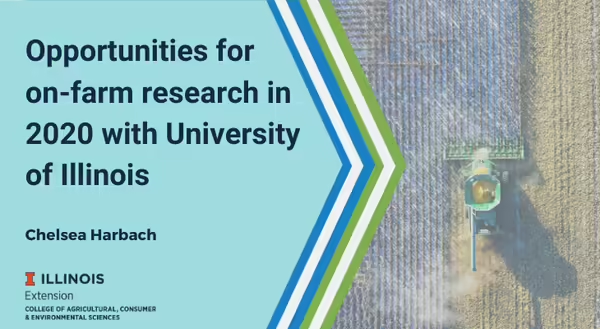
Planting season is right around the corner! With any hope, things will go much smoother this year than last year (although that's not a very high bar to pass).
Continue to keep an eye on the weather! This includes not only what is going on in your area, but also monitoring the snowpack and melt in the upper Midwest and into Canada. This can greatly influence the water table and planting in Illinois.
With that being said, I wanted to ensure that you readers are aware of a few different opportunities for on-farm research with the University of Illinois this 2020 growing season.
1. Are you in an area that has been a part of the tar spot epidemic on corn (especially in 2018)? Do you have fields that have been a part of the epidemic that are also on irrigated ground? Our on-campus Extension plant pathologist, Dr. Kleczewski, is looking for farmers that answered "yes" to one or both of these questions that are interested in some on-farm research on tar spot. It is pretty simple: you (the farmer) can go ahead and bulk-plant whatever hybrid you were planning on planting (there is no resistance available commercially for tar spot). Then, Dr. K's crew would come to cut alleys around V8/10, creating the "plots" in the field. The maximum area that is needed for the study is 180' wide by 200' deep (8/10 of an acre). These will be trials to test fungicide and timing on the control of tar spot, all applied by Dr. K's crew. Farmer collaborators will be compensated for their space and get to keep the grain.
2. Do you have soybean fields that have succumb to white mold (Sclerotinia stem rot) in the past? Are any of these fields on irrigated ground? If you answered yes to one or both of these questions, Dr. Kleczewski has a trial he would like to put on your farm! These trial will be 250' wide by 200' (1.15 acres) and will be a fungicide and timing trial as well. Similar to the tar spot trials, these fields can be bulk-planted and alleys will be cut into the field, delineating the plots, after soybean emergence. Farmer-collaborators will be compensated for their space and may keep the grain.
3. Data-Intensive Farm Management Program (DIFM): In a collaborative effort with Dr. David Bullock (UIUC Department of Agriculture & Consumer Economics), the Commercial Agriculture Extension team is looking for farmers that would like to participate in the DIFM program. For this program, we are looking for participants that are progressive and interested in learning how the use of specialized software working with variable rate equipment and GPS technologies can build high-tech trials that can produce highly informative information for the researchers and farmers alike. Farmers interested must be willing to provide at least 80 acres for the project for which a boundary (shape file) is provided for trial design, along with the latest soil fertility information for the field (as a shape file if possible). An A-B line for planting, fertilization, and harvest, and prior yield map, if available, will help with the trial design as well. Dr. Bullock and his team will provide the farmer with all of the files they need for variable rate applications (fertilizer and/or seeding rates).
Are you interested in participating in one or both of the crop disease trials? Does the DIFM project sound like something you would like to be a part of? Shoot me an email or give me a call and I can make sure you get connected with Dr. Kleczewski or Dr. Bullock in a timely fashion. (email: charbach@illinois.edu, phone: 309-734-1098